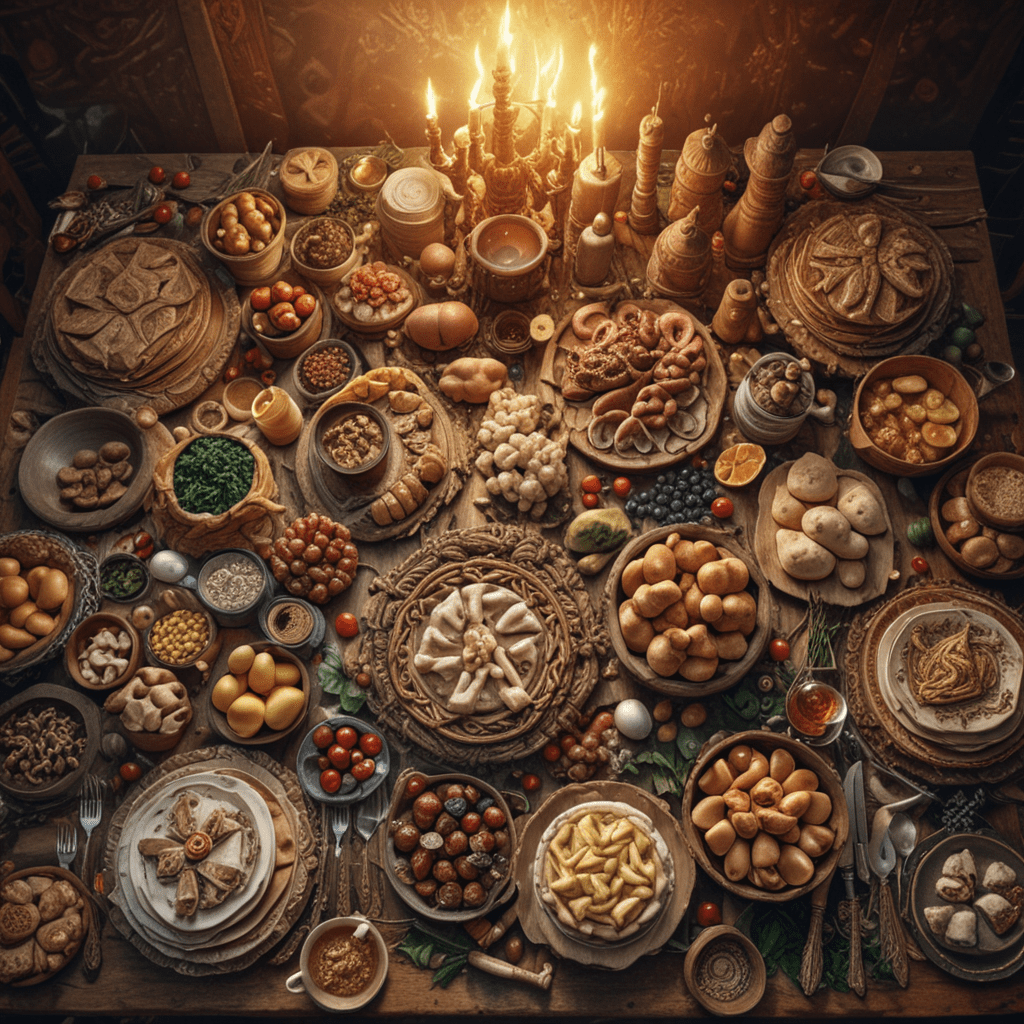Slavic Mythology and Traditional Cuisine
Slavic mythology has deeply influenced the traditional cuisine of Slavic cultures. From ancient beliefs and deities to rituals and festivals, supernatural creatures, and animal sacrifices, Slavic mythology has shaped the way food is prepared, consumed, and celebrated within these cultures.
1. Slavic Beliefs and Deities Related to Food
Slavic mythology features a pantheon of deities associated with food and agriculture. The goddess Mokosh, for instance, is believed to protect crops and livestock, while the god Veles is considered the patron of cattle and wealth. These deities were often invoked through rituals and offerings, ensuring bountiful harvests and prosperity.
2. Rituals and Festivals Involving Food Offerings
Slavic festivals and rituals were closely tied to the agricultural calendar. On the eve of major holidays, such as Christmas and Easter, special meals were prepared and shared as offerings to deities and ancestors. These meals were often symbolic, representing gratitude for the harvest and prayers for future abundance.
3. Supernatural Creatures and Their Influence on Cuisine
Slavic mythology is populated by a wide range of supernatural creatures, including dragons, goblins, and mermaids. These creatures were often believed to have an influence on food and cooking. For instance, dragons were associated with fire and heat, while mermaids were believed to control water and fish. As a result, certain foods were avoided or consumed in specific ways to appease these creatures.
4. Plant Symbolism and Herbal Remedies
Slavic mythology attributed specific powers to various plants. Oak leaves, for example, were believed to ward off evil spirits, while willow branches were used for healing. As a result, many Slavic dishes incorporate herbs and plants for both culinary and medicinal purposes. Traditional remedies often utilize plants to treat a variety of ailments, from headaches to digestive issues.
5. Animal Sacrifices and Meat Consumption
Animal sacrifices played a significant role in Slavic mythology and religious practices. Cattle, pigs, and chickens were commonly sacrificed to deities in exchange for blessings and protection. Meat consumption was also an important part of Slavic cuisine, with various animals being raised and slaughtered for food. The choice and preparation of meat dishes were often influenced by mythological beliefs and rituals.
6. The Role of Bread in Slavic Culture
Bread holds a central position in Slavic cuisine, symbolizing life, fertility, and prosperity. Slavic cultures have a wide variety of traditional breads, each with its unique shape, ingredients, and rituals associated with its baking. Bread was often used as a sacred offering to deities and ancestors and was believed to have the power to ward off evil spirits. In many Slavic households, bread was considered the most important food item, and it was often the first thing offered to guests as a sign of welcome and hospitality.
7. Symbolic Dishes and Feasting Customs
Slavic cuisine also features a range of symbolic dishes and feasting customs that have been passed down through generations. For instance, the round-shaped loaf of bread known as "kolach" is traditionally served at weddings and other festive occasions, representing unity and abundance. Similarly, the sweet dish "kutia," made from wheat berries, honey, and poppy seeds, is often prepared for Christmas and other holidays, symbolizing fertility and the promise of a good harvest. These symbolic dishes play a significant role in Slavic cultural identity and community gatherings.
8. Food as a Source of Healing and Protection
Slavic mythology and traditional medicine attributed healing and protective powers to many foods. Certain herbs, such as chamomile and St. John's wort, were believed to have medicinal properties and were used to treat various ailments. Slavic cultures also believed that certain foods could ward off evil spirits and bring good luck. For example, garlic was often hung in homes to protect against vampires, while rowan berries were believed to have protective powers against witches.
9. The Evolution of Slavic Cuisine over Time
While Slavic cuisine has maintained its core traditions and beliefs over centuries, it has also evolved and adapted to new influences. Contact with other cultures, such as the Vikings, Mongols, and Ottoman Turks, introduced new ingredients and cooking techniques that were gradually incorporated into Slavic cuisine. Over time, Slavic cuisine has become a diverse and eclectic blend of traditional flavors, regional variations, and modern innovations, while still retaining its deep roots in Slavic mythology and folklore.
10. Contemporary Influences of Slavic Mythology on Food Traditions
Despite the modernization of Slavic societies, the influence of Slavic mythology on food traditions remains evident in many ways. Traditional dishes, such as kolach and kutia, continue to be prepared and enjoyed during festivals and family gatherings, preserving the cultural and spiritual significance of food. Additionally, contemporary Slavic cuisine has seen a resurgence of interest in traditional ingredients and recipes as people seek to reconnect with their cultural heritage. From artisanal bread makers specializing in traditional sourdough to restaurants offering modern interpretations of classic Slavic dishes, the influence of Slavic mythology on food traditions persists and continues to inspire creativity and innovation in the culinary world.
FAQ (Frequently Asked Questions)
- What is the significance of bread in Slavic cultures?
Bread holds a central position in Slavic culture, symbolizing life, fertility, and prosperity. Traditional breads are used as offerings to deities and ancestors and believed to have protective powers. - Are there any symbolic dishes in Slavic cuisine?
Yes, Slavic cuisine features symbolic dishes such as kolach (a round-shaped loaf served at weddings), kutia (a ceremonial dish made from wheat berries and honey), and poppy seed cake, which represent unity, fertility, and good luck. - How has Slavic mythology influenced contemporary food traditions?
The influence of Slavic mythology on food traditions is evident in dishes like kolach and kutia, preserved in modern contexts. Additionally, contemporary chefs are using traditional ingredients and recipes to create fresh interpretations of Slavic cuisine.




